 |
Giralomo Benzoni, Americae pars quinta nobilis & admiratione plena Hieronymi Benzoni Mediolanensis . . . (Frankfurt, 1595). |
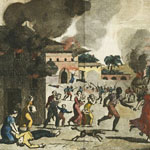 |
Incendie du Cap. Révolte general des Négres. Massacre des Blancs (Paris, 1815). |
Shown here are two views of the same place, the Spanish possession Hispaniola, later the French colony Saint Domingue, later the independent black nation of Haiti. In the first, the Italian traveler Girolamo Benzoni describes an assault on a settlement of fugitive slaves in the mid-1550s. In the second, some 240 years later, the black attack on Cap Francois in 1793 caps the rebels’ struggle against slavery. Shown are documents on slave resistance in North America.
|
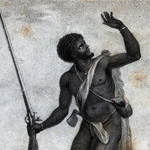 |
“A Rebel Negro armed & on his guard,” in John Gabriel Stedman, Narrative of a Five Years’ Expedition Against the Revolted Negroes of Surinam (London, 1796). |
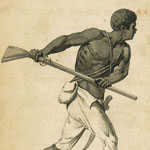 |
“Leonard Parkinson, a Captain of the Maroons,” in Proceedings of the Governor and Assembly of Jamaica, in Regard to the Maroon Negroes (London, 1796). |
| |
|
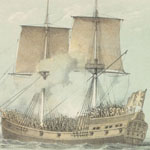 |
“Representation of an Insurrection on Board a Slave Ship,” engraving in Carl Bernhard Wadstrom, An Essay on Colonization Particularly Applied to the Western Coast of Africa, with Some Free Thoughts on Cultivation and Commerce… (London, 1794). |
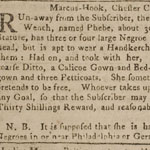 |
Run away from subscriber, a negro wench named Phebe….
The Pennsylvania Gazette, September 1, 1763
|
 |
Run away from Mr. Andrew Fresneau….
The Pennsylvania Gazette, July 18, 1765
|
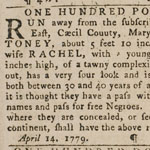 |
Run away from subscriber, a negro man called Toney…
The Pennsylvania Gazette, July 7, 1779
|
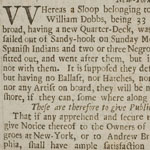 |
Whereas a sloop belonging to…
The American Weekly Mercury, June 3/10, 1721
|
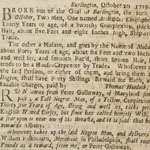 |
Broke out of the goal of Burlington…. Run away from Peter Galloway….
The American Weekly Mercury, October 23/30, 1729.
|
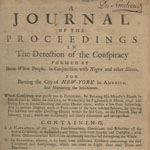 |
Daniel Horsmanden, A Journal of the Proceedings in the Detection of the Conspiracy Formed by Some White People, in Conjunction with Negro and Other Slaves, for Burning the City of New-York in America and Murdering the Inhabitants (New York, 1744). |
New York City, 1741. A growing population of slaves and indentured white laborers had city authorities on edge. When a series of fires broke out in March and April, suspicion fell on a conspiracy of these lower classes. A white servant, with promise of freedom and a reward, implicated about a hundred blacks and whites in a plot to burn out the government and take over the city. A lengthy series of trials resulted in the hanging of several whites. Eighteen blacks were hanged, and thirteen burned at the stake. All claimed innocence, and many historians think that the trials and executions were spurred by white paranoia rather than any real insurrection.
|
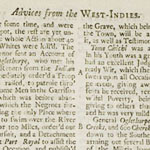 |
Account of the Stono Rebellion in The Gentleman’s Magazine or, Monthly Intelligencer, March, 1740.
South Carolina, 1739. About twenty slaves gathered by the Stono River, near Charleston, raided a store for arms, and marched towards St. Augustine, in Florida. The Spanish had offered land and freedom to slaves fleeing the British territories. The slave legion grew to nearly one hundred and killed about twenty-five whites on their march. Armed whites intercepted them near the Edisto River, killed about thirty, and captured and executed the rest. |
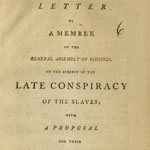 |
St. George Tucker, Letter to a Member of the General Assembly of Virginia, on the Subject of the Late Conspiracy of the Slaves, with a Proposal for Their Colonization (Baltimore, 1801).
Virginia, 1800. Thomas Prosser’s slave Gabriel was a literate, skilled blacksmith who hired out in Richmond, where he was influenced by the political rhetoric of liberty and equality of the day. He organized fellow slaves, free blacks, and some radical white workers in a plot to seize Richmond and overthrow the government. The conspiracy was well planned and the rebels well armed. A storm set their attack back a day, enough time for authorities to learn of it and move against the rebels. Several trials lasted over two months, and twenty-six slaves were hanged. This was the widest-ranging and best-planned insurrection yet witnessed, and nearly succeeded. |
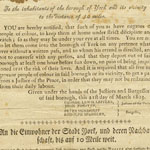 |
To the Inhabitants of the Borough of York and Its Vicinity to the Distance of 10 Miles (York, Pa., 1803).
Pennsylvania, 1803. When a black servant woman was convicted of attempting to poison her mistress, she swore vengeance upon the town. And for four weeks thereafter, at least ten buildings in York were torched, along with several others in nearby towns. A black girl caught setting fire to a building implicated several others in what authorities called “a conspiracy or combination of a number of Negroes to effect the destruction of the town by fire.” Twenty blacks were arrested and convicted of arson. At the time, the population of York County numbered 37,000, including 1,300 blacks, of whom 500 were slaves. |
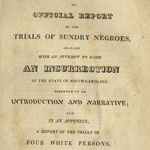 |
An Official Report of the Trials of Sundry Negroes, Charged with an Attempt to Raise an Insurrection in the State of South-Carolina (Charleston, 1822).
South Carolina, 1822. Denmark Vesey, an African-born free black carpenter of Charleston, was accused of plotting a major slave insurrection involving upwards of 9,000 blacks, to attack Charleston and sail away to freedom with the aid of Haitians. Tried and convicted, Vesey and thirty-six others were hanged. And, as with the 1741 New York uprising, historians have recently questioned whether this was a real conspiracy or part of a larger and persistent attack by whites on free blacks in South Carolina. Prior to the alleged uprising, white authorities had suppressed the large African Methodist Episcopal Church, with a congregation of some 1,200 free blacks and slaves. White authorities long sought to restrict free black life, and some argue the Vesey affair was one more such effort. |
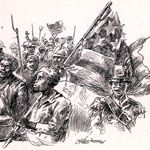 |
“‘On to Orleans’: the Negro Insurrection,” illustration in Maurice Thompson, The Story of Louisiana (New York, 1888).
Louisiana, 1811. In the turmoil of continuing conflict with Spanish forces in the territory, some five hundred slaves rose up to attack New Orleans, burning plantations and recruiting other slaves on their way. White militias quickly organized and attacked the group, killing most of them. Sixteen leaders were captured and executed, their severed heads mounted on poles to terrorize other slaves. |
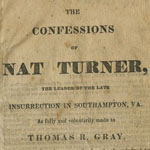 |
The Confessions of Nat Turner, the Leader of the Late Insurrection in Southampton, Va. . . . (Baltimore, 1831).
Virginia, 1831. The most shocking of the 19th century slave revolts was led by Nat Turner, a literate and deeply religious slave inspired by prophetic visions. Fifty-five whites were killed as Turner’s small band attempted to hack their way to freedom in the remote Great Dismal Swamp. Turner’s men were quickly subdued, though Nat himself escaped and hid for several weeks. Finally captured, he was hanged, and skinned. Some fifty-five slaves were executed in response, considerably more than were in Turner’s legion, and some two hundred others were killed by roving white mobs. Though confessing to everything, Turner at his trial pleaded not guilty, “saying to his counsel, that he did not feel so.” His chilling and stark confession was a best-selling pamphlet. |
















